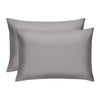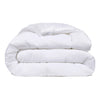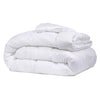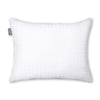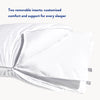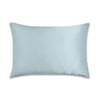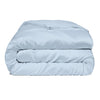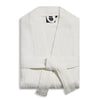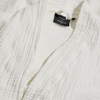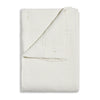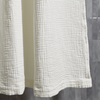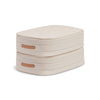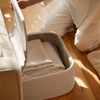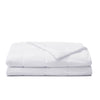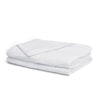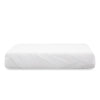The Daily Miracle
How To Remove Glue From Fabric: 7 Tips
Published
February 17, 2024
Author
Bridget Reed

Dealing with glue on fabric can be a sticky situation, literally. Whether you're an avid crafter or just had an accidental spill, removing glue from fabric is a common challenge. This sticky situation is not just about the unsightly stain but a full-on test of your fabric's resilience and your cleaning prowess.
The issue demands immediate attention, whether it's a glob of super glue on your favorite shirt or a smear of craft glue on a tablecloth. However, removing glue from fabric isn't a one-method-fits-all scenario. The variety of glues and fabrics requires a nuanced approach to ensure effective removal without damaging the textile.
In this article, we will guide you through various tips to remove glue from fabric, ensuring your textiles remain pristine. But first, check your care labels! Not all of these tips will work for all types of fabric.
1. Don’t Skip Your Pre-Treatment
The initial response to a glue stain is pivotal. As soon as you notice the glue, it's time to act.
Start by carefully removing any excess glue. This is a delicate process: too much force, and you risk embedding the glue deeper into the fabric fibers; too little, and you leave too much glue behind.
A plastic scraper, like a credit card, works well for this, allowing you to lift the glue without damaging the fabric. This pre-treatment stage sets the tone for the entire cleaning process.
It's an all-important step in preventing the glue from solidifying and bonding further with the fabric. Once the excess is off, lightly dab the area with a clean, dry cloth to remove any residual glue.
2. Cold Water Rinse
Cold water can harden certain types of glue, making them less sticky and easier to remove. Submerge the stained area in cold water and gently agitate the fabric.
This action helps to loosen the glue particles, gradually detaching them from the fibers. It’s essential to keep the water temperature cold. Warm or hot water can have the opposite effect, especially with certain glue types like school glue or PVA, potentially causing them to set into the fabric even more.
The cold water rinse is also a gentle approach, ideal for delicate fabrics that might not withstand harsher cleaning methods. This step requires patience; you may need to soak the fabric for a significant period, occasionally rubbing the stained area between your fingers to encourage the glue to lift.
It's a balancing act — applying enough agitation to aid in glue removal while being gentle enough to preserve the fabric's quality.
3. Apply a Solvent
Common solvents include rubbing alcohol, nail polish remover (acetone), or a commercial glue remover — things you might simply have in your pantry. However, this step requires caution. Start by testing the solvent on a small, hidden area of the fabric to ensure it doesn't cause discoloration or damage.
Once you’ve confirmed its safety, apply the solvent to a clean cloth or cotton ball and gently dab it onto the stained area. The solvent works by breaking down the glue's chemical structure, making it easier to lift from the fabric.
It's important to avoid saturating the fabric with the solvent, as this could lead to further damage. Instead, use a light touch, reapplying the solvent as needed. As you treat the stain, you’ll notice the glue starting to dissolve and lift away from the fabric.
4. Use a Gentle Blotting Technique
The technique of blotting is crucial in the glue removal process. It’s not just about applying the solvent but about how you apply it.
Once the solvent is on the cloth, press it gently against the stained area. This action transfers the solvent to the glue without excessive force. It's essential to blot, not rub. Rubbing can spread the glue, making the stain larger or pushing the glue deeper into the fabric's fibers.
Blotting, on the other hand, lifts the glue off the surface gently. Keep rotating the cloth to a clean area as the glue transfers onto it, preventing the reapplication of the glue back onto the fabric.
This process might be slow, but it's effective. The solvent loosens the glue, and the blotting action removes it. Patience is key here. You may need to repeat this process several times, depending on the size and severity of the glue stain.
5. Use a Gentle Detergent
When it comes to washing your stained fabric, a gentle yet effective detergent is key. At this stage, our Miracle MadeⓇ Laundry Detergent Sheets are a lifesaver.
These sheets excel in tackling tough stains like glue and are designed for extra strong cleaning power. Their formulation is a perfect blend of effectiveness and gentleness, ensuring your fabric gets the thorough clean it needs without any harshness.
Plus, their hypoallergenic ingredients make them suitable for even the most sensitive skin. When dealing with glue stains, it’s time to wash the fabric after pre-treating and blotting.
Here, our detergent sheets shine. Their ultra-concentrated nature means you get powerful cleaning action with just a small, space-saving product.
This efficiency is complemented by their eco-friendly design — all-natural ingredients and biodegradable packaging that align with our environmental ethos. Using these sheets not only aids in removing any remaining glue residue but also ensures the fabric remains soft, fresh, and impeccably clean.
6. Soak if Necessary
For particularly stubborn stains, soaking the fabric may be required. This isn't just a matter of dunking the fabric in water but creating an effective soaking solution.
Fill a basin with warm water and add a portion of our Miracle MadeⓇ Laundry Detergent Sheet. Let the fabric soak in this solution, allowing the detergent's properties to penetrate and work on loosening the glue.
The duration of the soak depends on the glue’s tenacity. For some, a short soak will suffice, while others may need to be left overnight.
During this time, the combination of warm water and our detergent works together, softening and breaking down the glue. Periodically, you might want to gently agitate the fabric in the water, helping to loosen the glue’s grip.
7. Repeat As Needed
This is true of just about any kind of stain, whether it’s glue or tea. In some cases, one round of treatment might not be enough to completely remove the glue stain. If remnants of the stain persist, don't be discouraged. It's not uncommon for tough stains like glue to require multiple treatments.
Repeating the process is often the key to success. Go back to the pre-treatment step and gently scrape away any remaining glue.
Follow this with another round of solvent application, blotting, and possibly soaking, depending on the stain's severity. Each repetition of these steps incrementally reduces the stain, bringing you closer to completely removing it. It's important to approach each repetition with the same level of care and attention as the first.
The Bottom Line
Removing glue from fabric might seem daunting, but it's a challenge that can be met with the right approach and tools. The key to success is a combination of prompt action, appropriate cleaning techniques, and the use of effective, fabric-friendly products like our Laundry Detergent Sheets.
Each step in this guide, from pre-treatment to air-drying, plays a crucial role in ensuring the complete removal of the glue stain while preserving the fabric's integrity. Remember these steps the next time you're faced with a glue mishap.
With patience, persistence, and the right products, you can tackle any glue stain and keep your fabrics looking their best.
Sources:
Your Complete Guide to Understanding Care Labels | Planet Care


